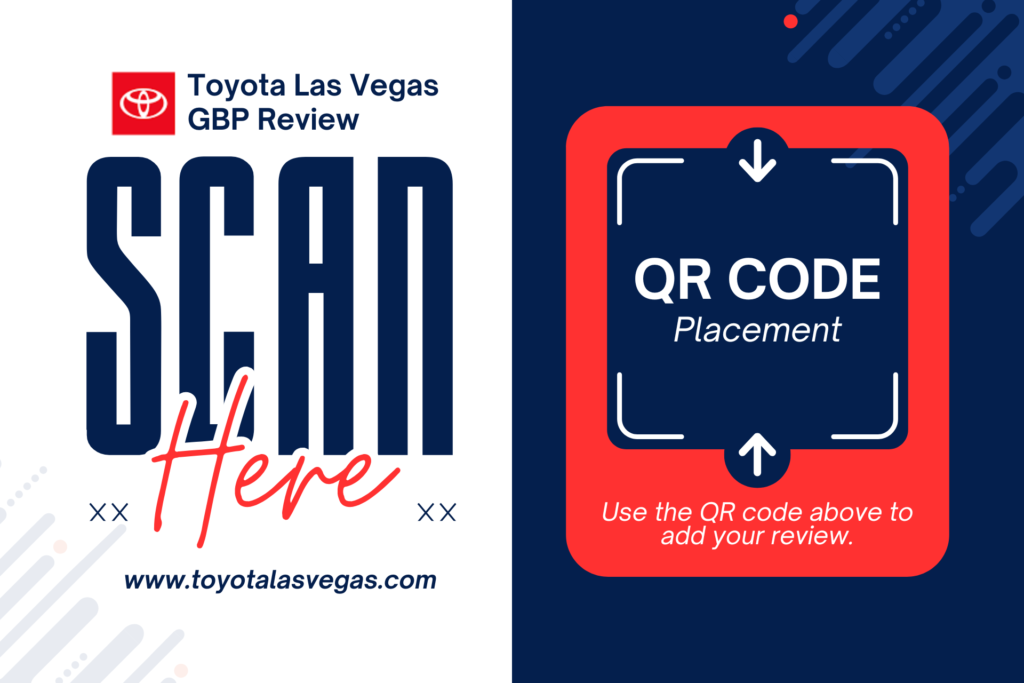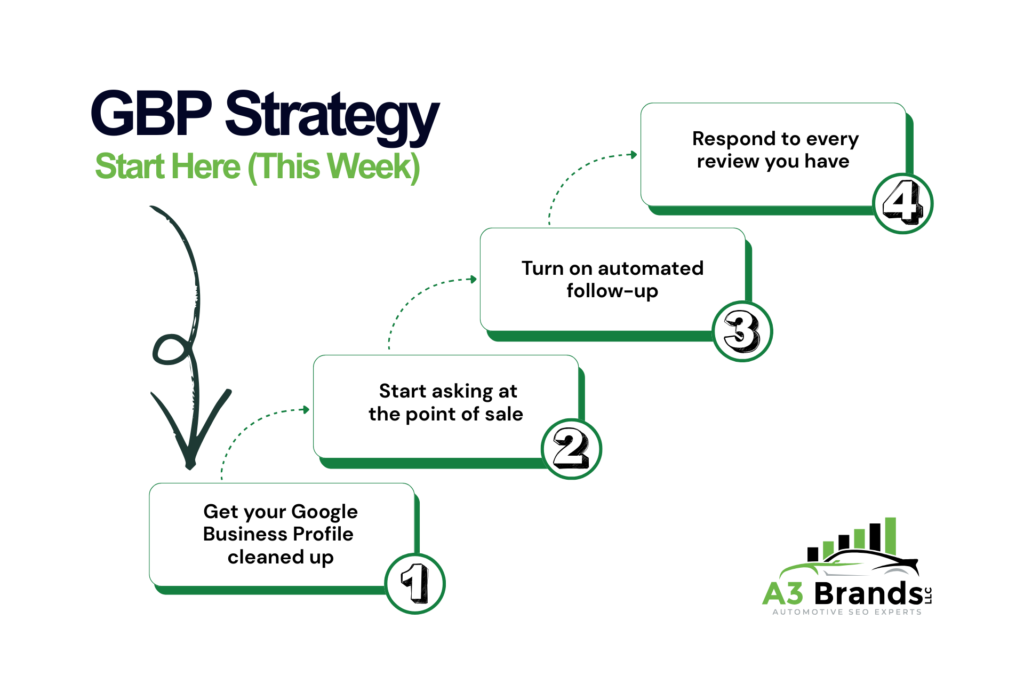I was sitting with a Chevy dealer in Texas a few months ago, and he pulled up his Google Ads dashboard. $11,000 that month. I asked him to pull up his main competitor across town. They were spending about $4,500*.
“So you’re crushing them in traffic, right?”
He pulled up both stores side by side on Google Maps. “I don’t think so. Look at this.”
His competitor showed up first in the map pack for every search we tried. They had 640 reviews at 4.6 stars, with fresh ones from the past few days. His store? 287 reviews, 4.1 stars, and the most recent one was from three weeks ago.
“Every time someone searches, they see them first. We’re spending double to make up for it.”
*Paid Search cost estimate from Semrush
Here’s What’s Actually Happening
When someone searches for a dealership in your area, Google shows three stores in that map pack at the top. Your review profile is a major factor in whether you’re one of those three or buried down the page where nobody scrolls.

It’s not just about total review count.
Google looks at how many you’re getting every week, your star rating, how fast you respond, and what people are actually saying. A store that had 10 reviews come in last week looks active. A store that had zero looks like it might be out of business.
The dealers who figured this out years ago are now paying 40-50% less for the same traffic you’re buying with paid ads. They own the map pack. They show up organically for every “near me” search. And when someone does click a paid ad, they still check the reviews before calling.
You’re competing against your own reviews even when you pay for the click. That’s why local SEO for car dealerships has become non-negotiable.
The Dealerships We Work With Who Get This Right Do Four Things
1. They ask every single customer
Not sometimes. Not when they remember. Every delivery, every service write-up. The sales manager hands over the keys with a QR code card: “Would you mind sharing a quick review about your experience? Takes 60 seconds.”
Service advisors do the same thing when they close a repair order. It’s printed right on the receipt.
The stores pulling 50-80 reviews a month aren’t doing anything fancy. They just ask every time.
2. They follow up within 48 hours
Most people don’t leave a review on the spot. That’s fine. Your CRM should automatically send a text message 24-48 hours after delivery or service:
“Hey John, thanks for choosing [dealership]. If you have a minute, we’d really appreciate a quick review.” Include your Google review link at the end.
Simple. No pressure. Just a reminder. The stores that automate this see 3x more reviews than the ones relying on people to remember.
3. They respond to everything, fast
Every positive review gets a quick thank-you within 24-48 hours. Every negative review gets handled within 12 hours, and someone with authority responds publicly with a phone number and name.
“We’re sorry we missed the mark on your oil change, Mike. I’ve looked into what happened with the wait time, and I’d like to make this right. Please call me directly at [number]. – James Torres, Service Director”
Future customers read those responses. They’re not just seeing the complaint, they’re seeing how you handle problems. That matters more than you think.
4. They put reviews on their website where they actually help
If someone lands on your “2025 Tacoma” page because they searched for it, and they see five recent reviews from people who just bought Tacoma at your store, that’s bottom-of-the-funnel proof right where it counts.
Most dealers either don’t have reviews on their site at all, or they dump them all on some generic “testimonials” page nobody visits. Put them on the pages people actually land on. Model pages. Service pages. Wherever the decision is being made.

An example is a QR code that leads to your Google Business Profile review page.
What Doesn’t Work (And What Most Dealers Are Doing Wrong)
Buying reviews
Don’t.
Google will filter them, possibly suspend your profile, and you’ll lose months of legitimate reviews in the process. We’ve seen it happen.
Only asking happy customers
Also known as “gating.” Also against the rules. Also a fast way to get penalized. Ask everyone. If someone’s unhappy, you want to know about it so you can fix it before they leave a 1-star review.
Ignoring negative reviews
Silence makes it worse. A complaint with no response looks like you don’t care. A complaint with a professional response and a resolution looks like you run a tight operation that fixes problems.
Offering incentives
“Leave us a 5-star review and we’ll give you a free oil change.” Immediate policy violation. Don’t do it.
If Your Google Business Profile Gets Suspended
This is the call nobody wants to get: “Our Google listing is gone.”
Profile suspensions happen, and they’re usually triggered by one of a few things. Fake or bought reviews. Multiple listings for the same location. Wrong business category. Asking customers to leave reviews in exchange for something. Letting an old marketing company set up profiles that violated policies.
When it happens, your dealership disappears from Maps. All your reviews vanish. Your phone stops ringing from local searches. And the worst part? It takes weeks to fix, not days.
Here’s what to do immediately:
First, don’t panic and don’t create a new profile. That makes it worse. Google sees it as trying to circumvent the suspension.
Second, request reinstatement through your Google Business Profile dashboard. You’ll need to explain what happened and what you’ve changed to comply with policies. Be honest. If you don’t know why you were suspended, say that and ask.
Third, document everything. When the suspension happened, what you were doing before it happened, any third-party services that had access to your profile. Google will ask.
Fourth, be patient. Reinstatement reviews can take 3-5 weeks, sometimes longer. There’s no way to speed it up by calling or escalating. You just have to wait.
The better approach: don’t get suspended in the first place.
This is why we’re so strict about compliance. No gating. No incentives. No fake reviews. No shortcuts. The dealers who follow the rules don’t have to deal with this nightmare.
If your profile is suspended right now, or if you’ve been down this road before and want to make sure it doesn’t happen again, that’s something we can help you navigate. We’ve been through this enough times to know what Google is actually looking for in a reinstatement request.
What This Actually Looks Like in Practice
In 20 years working exclusively with dealerships, we see the same pattern over and over. A store sitting at 300-400 reviews, getting maybe 8-10 per month, decent traffic but rising costs. They build a consistent system: QR cards at every touchpoint, automated follow-up, fast responses, reviews on their model pages.
Six to nine months later, they’re getting 40-60 new reviews monthly, their star rating has climbed, and their cost per lead has dropped significantly because organic and map traffic is covering what they used to pay for.
It’s not magic. It’s just consistency. When reviews become part of your broader automotive SEO strategy, the compound effect is remarkable.
Start Here (This Week)
Week 1: Get your Google Business Profile cleaned up
Make sure your hours are right, photos are current, services are listed, and all your contact info is accurate. If that stuff is wrong, nothing else matters.
Week 2: Start asking at the point of sale
Print 500 business cards with a QR code that goes straight to your Google review page. Hand them out at delivery and service checkout. Train your team on a 15-second script.
Week 3: Turn on automated follow-up
Work with whoever manages your CRM to trigger a text message 24-48 hours after delivery and service completion. One message. Not pushy. Just a reminder with a link.
Week 4: Respond to every review you have
Go back through your last 30 days of reviews and respond to all of them. Set a standard: someone on your team checks reviews every morning and responds the same day.
Do those four things and you’ll see momentum within 60 days. Not miracles, but consistent weekly reviews and better visibility in the map pack.

Look, you can keep paying Google $8K, $10K, $12K a month to compete with dealers who figured this out three years ago. Or you can build a system that generates the same traffic for a fraction of the cost.
We’ve been doing this for 20 years, exclusively with dealerships. We’ve seen the stores that take this seriously and the ones that don’t. The gap keeps getting wider.
Reviews are just one piece of a complete dealership SEO approach. The real power comes when you connect technical optimization, content strategy, and AI-powered solutions into one system. That’s why we’ve built comprehensive services that cover everything your dealership needs to dominate local search.
If you want us to take a look at where you stand right now, we’ll pull your review profile, compare it to your top three local competitors, and show you exactly where you’re losing ground. No charge for the audit. If it makes sense to work together after that, we’ll talk about it. If not, at least you’ll know what you’re up against.
Or call Tim directly at (302)-394-6940. He’ll walk you through what we’re seeing in your market and what it would take to close the gap.
Tim Boyle

Your Google Reviews Are Costing You Sales (Here’s How to Fix It)

3 Ways AI Is Changing Automotive Search in 2026 (And What Your Dealership Should Do About It)

What Your SEO Agency Won’t Tell You About EV Search Traffic (And What Multi-Store Operators Need to Know)

How Local Dealers Are Losing Sales to Competitors They’ve Never Met – And How to Steal Them Back

Stop Paying Google Just to Stay Visible: How Dealerships Are Building Traffic They Actually Own


